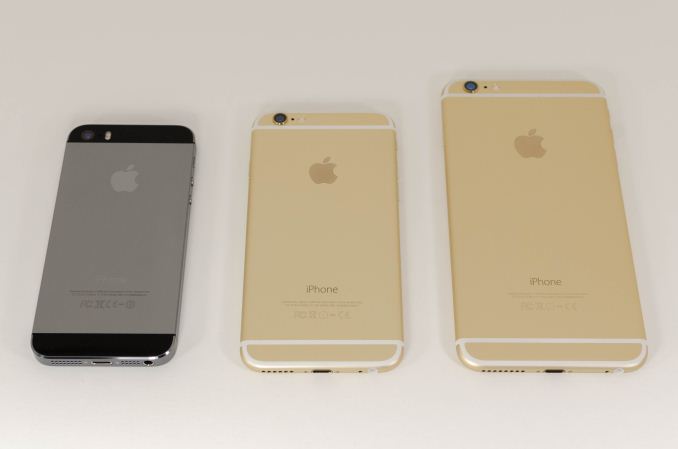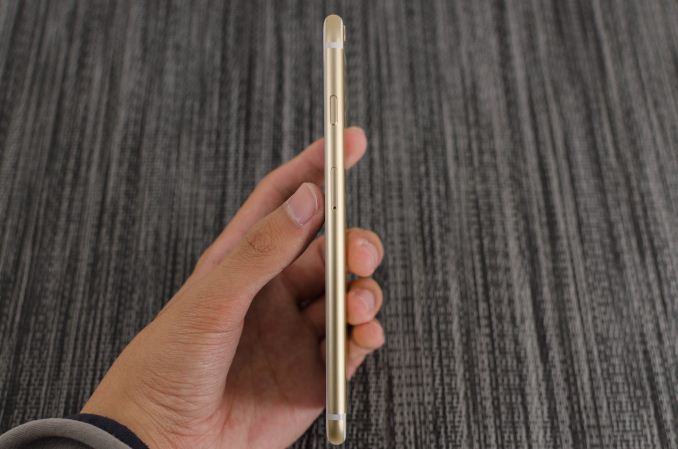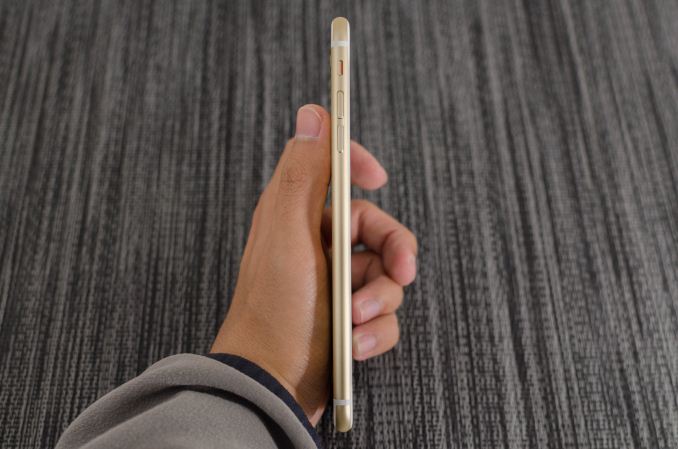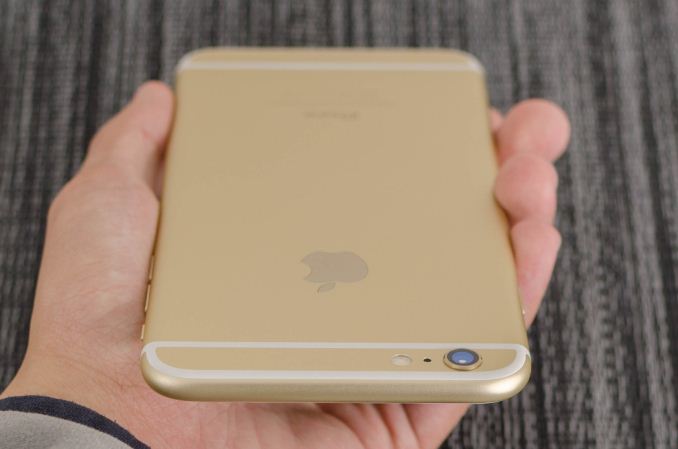The iPhone 6 Plus Mini-Review: Apple's First Phablet
by Joshua Ho on September 30, 2014 8:00 AM EST- Posted in
- Smartphones
- Apple
- Mobile
- iOS
- iPhone 6 Plus

While we’ve also written about the iPhone 6, the iPhone 6 Plus needs its own review in order to really understand the various features of the device that would otherwise be buried in the context of the iPhone 6. Without question, this device represents a significant departure from the way Apple has competed in the smartphone space. Until now, Apple hasn't competed in the phablet space and has thus avoided competing with Galaxy Note line that has been established as the dominant phablet for the past 3-4 generations. As a result, Apple occupies a fast-follower position at best.
This brings us to the iPhone 6 Plus, which really is an extension of the iPhone 6. Both phones share the same SoC, NAND configurations, front and rear camera sensors, LED flash module, industrial/material design, TouchID home button, earpiece and speaker configuration, WiFi/BT chipset, modem, and button layout. At this point, I’m going to stop listing similarities because the iPhone 6 Plus is interesting for its differences. Unlike similarities, the differences are simple. The iPhone 6 Plus is bigger, the display has higher pixel density, the camera has optical image stabilization, and iOS 8 has new app designs to take advantage of the larger screen. The iPhone 6 Plus is also more expensive, with the 16GB version starting at the same price as the 64GB version of the iPhone 6.
While I’ve already discussed the design of the iPhone 6, it’s important to see whether the same design translates to the iPhone 6 Plus. To this end, the iPhone 6 Plus does well. While the angular design of the iPhone 5 line would have looked and felt enormous in the hand, the shape is quite similar to the iPad line and is similarly comfortable in the hand, although the rounded edge really differentiates it, as does the control scheme. The only real issue here is that the top bezel on the front becomes surprisingly large, and this seems to contribute to a sense that the phone is top-heavy even though the phone is evenly balanced.
| Apple iPhone 5s | Apple iPhone 6 | Apple iPhone 6 Plus | |
| SoC | Apple A7 | Apple A8 | Apple A8 |
| Display | 4-inch 1136 x 640 LCD | 4.7-inch 1334 x 750 LCD | 5.5-inch 1920 x 1080 LCD |
| WiFi | 2.4/5GHz 802.11a/b/g/n, BT 4.0 | 2.4/5GHz 802.11a/b/g/n/ac, single stream, BT 4.0, NFC | |
| Storage | 16GB/32GB/64GB | 16GB/64GB/128GB | 16GB/64GB/128GB |
| I/O | Lightning connector, 3.5mm headset | ||
| Size / Mass |
123.8 x 58.6 x 7.6 mm, 112 grams |
138.1 x 67 x 6.9 mm, 129 grams |
158.1 x 77.8 x 7.1 mm, 172 grams |
| Camera |
8MP iSight with 1.5µm pixels Rear Facing + True Tone Flash 1.2MP f/2.4 Front Facing |
8MP iSight with 1.5µm pixels Rear Facing + True Tone Flash 1.2MP f/2.2 Front Facing |
8MP iSight with 1.5µm pixels Rear Facing + True Tone Flash + OIS 1.2MP f/2.2 Front Facing |
| Price |
$99 (16GB), $149 (32GB) on 2 year contract |
$199 (16GB), $299 (64GB), $399 (128GB) on 2 year contract |
$299 (16GB), $399 (64GB), $499 (128GB) on 2 year contract |
Overall, even though the iPhone 6 Plus is noticeably taller than the Galaxy Note 3 both feel similar in size. The iPhone 6 Plus is on the thinner side which makes a significant impression in the hand. At any rate, it’s physically impossible for me to use this device with one hand for most situations. It’s definitely a tablet in this sense, but in a much more compact and pocketable form factor.
"Bendgate"
Of course, drawing the comparison between the iPhone 6 Plus and Galaxy Note 3 inevitably raises the question of “bendgate”, which draws interesting parallels with “scuffgate” from the iPhone 5 generation. Unfortunately, I can’t destroy multiple review units in order to thoroughly investigate this issue. However, we can look at Consumer Reports’ data and come to a few conclusions about this problem. The first is that in the case of the iPhone 6 Plus, there appears to be an area near the bottom of the volume buttons that is a weak point as we see a clear failure of the casing in this area.
However, it seems that there is a significant amount of force needed in the first place in order to cause permanent deformation. Otherwise, everything that we’ve seen is primarily the result of fundamental differences between the two materials. It’s clear that in the case of the Galaxy Note 3 that a great deal of the structural rigidity is tied to the display itself, so the case doesn’t quite provide much in the way of protection as the polymer used is clearly in the elastic region all the way to failure. LG seems to have a different design though, as their polymer material has a clear case of brittle failure at the limit, which saved the display from shattering.
It's certainly possible to bend the iPhone 6 Plus (or really any phone or tablet), but the real issue here that hasn’t been addressed is the level of force needed to cause a certain level of elastic or plastic deformation in the material. This matters far more when discussing drop protection as the level of force in such a scenario is relatively small but applied over an extremely short period of time. There’s also no mention of force per unit area in any of these figures, so we can’t really have a serious discussion about this issue without the necessary data.














191 Comments
View All Comments
moose0422 - Thursday, October 2, 2014 - link
Agreed, I would much rather own a Windows Phone in the future over another Android device. I feel like Windows Phone offers an experience comparable to iOS, while different, that is still extremely stable.nerd1 - Wednesday, October 1, 2014 - link
iPhone is a cheap phone using cheap, last-gen components.akdj - Thursday, October 2, 2014 - link
Maybe the opposite? Had to be pretty cheap to develop the first 64bit SoC. Definitely 'last-gen'. Just as Quallcom executives. Every compared Touch ID to ANY implementation on an Android device? Why does my 5s SMOKE my Note 3 playing Asphalt 8 or even Temple Run? It's got half the cores, at half the clock speed with a third the RAM!? HmmmI'm thinking you're not REALLY a 'nerd'. Nerds are usually intelligent.
akdj - Thursday, October 2, 2014 - link
Supposed to beJust ask Qualcomm
(&) Ever compared Touch ID ...
(Sorry. Need an editor;))
jimbo2779 - Thursday, October 2, 2014 - link
While I agree with some of your post it is important to note that the 5S has a tiny low res screen where the note is running a much higher resolution. So the note is having to process a much larger image, the note 3 has almost 3x the pixels to push that the iPhone does it should be able to run much faster it is doing a third of the work.Also all of your talk about cores and ram etc are largely moot when talking about games as games have always been a predominantly single process heavy task so they do not benefit from the multiple cores but other types of apps will. Also more cores allow more tasks to run in the background without affecting performance of UI based tasks.
Most US models of the note 3 came with an Exynos chip at 1.9GHz where the iPhone 5S comes with a 1.3GHz A7, basic maths tells me this is hardly half.
Berenz - Thursday, October 9, 2014 - link
Ignore the maths - look at the stats. iPhone 6 smokes the competition in almost every case: http://www.anandtech.com/show/8559/iphone-6-and-ip...cheshirster - Thursday, October 2, 2014 - link
Have you seen Nexus 5 test results on anandtech?damianrobertjones - Thursday, October 2, 2014 - link
The Boxster is an amazing car and doesn't try to kill you, as much, like a 911 does. Yep I owned a 986 2.5l Boxster and currently have a 996 911.happycamperjack - Friday, October 3, 2014 - link
Iphone 5 was the closest iphone release to Galaxy S3, and it absolutely blew S3 away in terms of performance. It's not even close. Check the Anandtech review here.http://www.anandtech.com/show/6330/the-iphone-5-re...
Pretty much every benchmark shows that iphone is better. I'm not an Apple fanboy, I've used multiple iphones and android devices over the years. One thing all androids have in common is they are built like toys. Plasticy and break easily. I have no idea why anyone would pay the same price for a Galaxy compared to iphone.
I think Android makes a lot more sense as a tablet. Tablets behave more like PC, Androids give you that PC like freedom.
theduckofdeath - Monday, October 6, 2014 - link
When all valid arguments fail, use pointless car analogies....